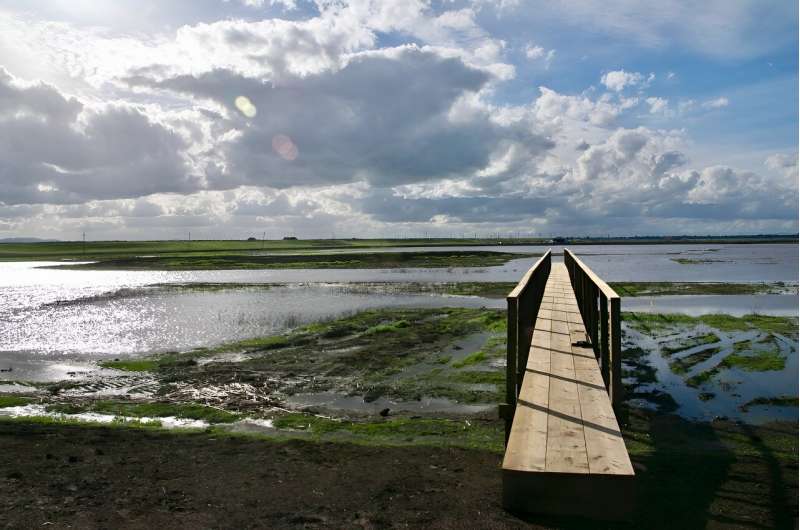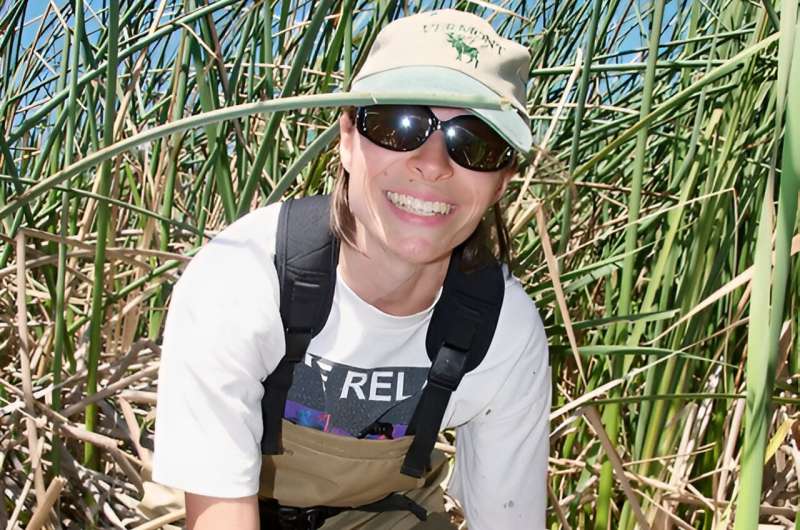This article has been reviewed according to Science X's editorial process and policies. Editors have highlighted the following attributes while ensuring the content's credibility:
fact-checked
trusted source
proofread
Rising sea levels could lead to more methane emitted from wetlands

As sea levels rise due to global warming, ecosystems are being altered. One small silver lining, scientists have believed, is that the tidal wetlands found in estuaries might produce less methane—a potent greenhouse gas—as the increasing influx of seawater makes these habitats less hospitable to methane-producing microbes.
However, research from biologists at Lawrence Berkeley National Laboratory (Berkeley Lab) and UC Berkeley indicates that these assumptions aren't always true. After examining the microbial, chemical, and geological features of 11 wetland zones, the team found that a wetland region exposed to a slight amount of seawater was emitting surprisingly high levels of methane—far more than any of the freshwater sites.
Their results, now published in mSystems, indicate that the factors governing how much greenhouse gas is stored or emitted in natural landscapes are more complex and difficult to predict than we thought.
"We looked at how many methanogens, the organisms that make methane, are present in soils at these sites and it wasn't really well correlated with the amount of methane observed," said senior author Susannah Tringe, director of Berkeley Lab's Environmental Genomics & Systems Biology Division. "And even if you look at the amount of methanotrophs, organisms that eat methane, in combination with methanogens, that doesn't seem to fully explain it."
Tringe and her colleagues took soil samples from the 11 sites and used high-throughput sequencing to analyze DNA from organisms found in the samples, including bacteria, viruses, and fungi. They examined which genes were present in the sequences and mapped them to known functions—for example, identifying genes known to be involved in metabolizing nitrogen or genes from bacteria that use sulfate during respiration. Then they worked to model how the genetic information they found, combined with chemical factors in the soil and water, could result in the methane emissions they observed.
Across most of the sites, which ranged from freshwater to full seawater salinities, the amount of methane emitted was inversely related to the amount of salt water that was flowing in and mingling with the river water. But at one site, which had been restored in 2010 from a seasonal grassy pasture for livestock grazing back to its original wetland habitat, the team saw high methane emissions despite the moderate amount of salt water.
Seawater contains more sulfate (an ion with sulfur and oxygen) than freshwater, leading to the assumption that increased influx of seawater in these environments would lead to less methane production as the methanogens that use CO2 to make cellular energy are outcompeted by the bacteria that use sulfate instead.
"Ultimately, we found that there were significant influences from other bacterial groups like the ones that break down carbon and even organisms that are better known as nitrogen cyclers, and we couldn't readily explain the methane emissions by something as simple as, for example, how much sulfate is available or how many methanogens are there," said Tringe.

Another concept in ecology is that restoring habitats to their native state can boost carbon storage, improve water quality, and increase wildlife populations. In recent decades, wetlands have been increasingly recognized as critical ecosystems for these environmental services, leading to widespread efforts to restore ecosystems by removing barriers, pollution, and non-native organisms.
Modeling work by co-author Dennis D. Baldocchi, Executive Associate Dean and professor of Biometeorology at UC Berkeley, suggests that although the restored wetland is adding greenhouse gas to the atmosphere currently, the ecosystem will stabilize and begin to serve as a net carbon sink within 100 to 150 years. This may not be the timeline that stakeholders were hoping for when they restored the area with the goal of carbon sequestration.
"We want to know if these systems will act as long-term carbon sinks," said Baldocchi. "And these microbiological investigations can help refine our models and predictions."
Tringe noted that other labs have observed increased methane production from wetland soils with increased salinity. Scientists from Duke University took soil core samples from a coastal freshwater wetland and exposed them to artificial seawater, and artificial seawater lacking sulfate. In both cases, methane production went up. Tringe's lab recently collaborated with Marcelo Ardón of North Carolina State University to analyze the microbial communities in those soils.
"There was this expectation that sulfate would be the most important thing. And in those studies, not only did salt water stimulate methane production, which again is kind of counter to the dogma that sulfate is important, it happened whether you had sulfate there or not; in fact the sulfate didn't have a big effect on the methane emissions," said Tringe. "So I think these experimental manipulations are reconfirming the story that there's more nuanced effects of seawater intrusion than just a sulfate addition, and also more nuanced factors behind ecosystem restoration."
More information: Wyatt H. Hartman et al, Multiple microbial guilds mediate soil methane cycling along a wetland salinity gradient, mSystems (2024). DOI: 10.1128/msystems.00936-23
Provided by Lawrence Berkeley National Laboratory




















